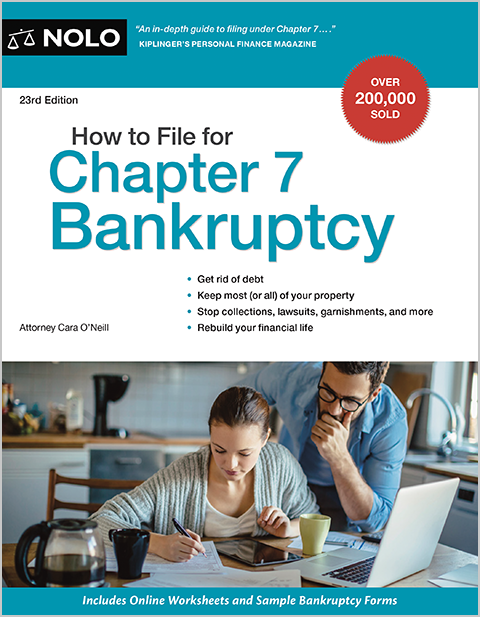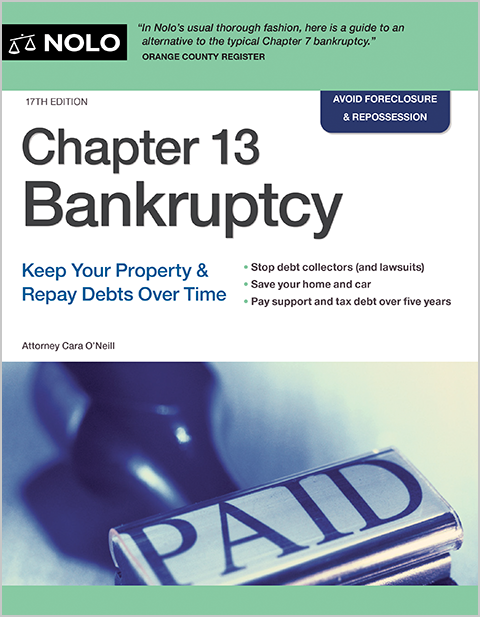A charged-off car loan is like any other vehicle loan in bankruptcy. If the lender has already repossessed the car, or you're willing to turn it in, you can "discharge" or wipe out the loan in your bankruptcy case. Learn about the differences between a charge off and repossession.
What Is A Charged-Off Car Loan In Bankruptcy?
Many people believe that once a loan appears as "charged off" on a credit report, they're no longer responsible for the debt. Unfortunately, this isn't the case.
When you stop paying on your car loan, the lender might take the "bad" loan off the books by transferring or selling your loan. Lenders often do this to improve the appearance of their financials. However, despite the transfer, you remain responsible for paying the balance to the creditor or debt collector who currently owns the debt.
You Can Discharge Your Charged-Off Car Loan in Your Bankruptcy
You'll list all charged-off loans in your bankruptcy paperwork to obtain a discharge of the debt, as you would all debts. The charged-off loan will be wiped out with other qualifying debts at the end of your bankruptcy case.
Be sure to include addresses for the lender, debt collector, collection agency, and debt buyer who attempted to collect the car loan. Your bankruptcy lawyer will likely list the charged-off loan under the original lender's name and add any debt collectors who might have contacted you (the petition includes a place to add other creditors you'd like to notify about the debt).
This procedure ensures the annoying collection calls and letters stop because all involved will have received a bankruptcy filing notice. Learn more about the documents needed to prepare a bankruptcy petition.
How to Characterize Your Charged-Off Car Loan in Bankruptcy
You'll likely list the charged-off car loan as an unsecured debt because the lender probably already repossessed the car. However, if you still possess it (which would be unlikely), you'll list it as a secured debt. Plan to return the car unless you can work something out with the lender.
Most current car loans are secured debts. A borrower agrees to secure a loan by pledging property that the lender can take back if the borrower fails to pay according to the contract terms. Doing so gives the lender a lien that allows the lender to repossess the vehicle, if necessary.
When Is a Charged-Off Car Loan Unsecured for Bankruptcy Purposes?
Once the lender repossesses the car, the lender has the collateral, making the lien no longer effective and the loan unsecured for bankruptcy purposes. Most charged-off car loans will be unsecured.
When Is a Charged-Off Car Loan Secured in Bankruptcy?
The loan balance is a secured debt if you have a charged-off vehicle loan and still possess the car. However, this would be highly unusual because most lenders repossess cars long before charging off the loan.
If you find yourself in this situation, you'd list the vehicle with secured debts when filling out your bankruptcy forms. Additionally, you'd complete a second form telling the lender and court whether you'd like to keep the car or return it to the lender.
You'll find more information in "More About Unsecured and Secured Car Loans In Bankruptcy," below.
Will Bankruptcy Get Rid of a Deficiency Balance?
Yes. A deficiency balance is the difference between what you owe and the proceeds from the vehicle auction. A lender has the right to collect a deficiency balance after repossession in most states, but bankruptcy wipes out deficiency balances. You'll list the deficiency balance as an unsecured debt because you'd no longer be in possession of the car.
More About Unsecured and Secured Car Loans In Bankruptcy
Below, you'll find information about how secured and unsecured debts are handled in Chapters 7 and 13.
Unsecured Debts in Chapters 7 and 13
In Chapter 7 bankruptcy, almost all unsecured debts get discharged (student loans are a notable exception). You'll no longer owe a charged-off vehicle loan after your bankruptcy.
In Chapter 13 bankruptcy, unsecured debts usually receive a portion of the balance paid out over the life of the plan. At the end of the case, you'll receive a discharge of any remaining amount owed.
Secured Debts in Chapter 7 Bankruptcy
You have a secured loan if you're making car payments when you file for Chapter 7 and still possess the vehicle. The bankruptcy court will discharge the car loan at the end of the case. But that doesn't mean you'll lose it automatically.
Filers who satisfy the requirements to keep the car in Chapter 7 either "reaffirm" the car loan (agree to keep making payments in a new contract) or "redeem" the vehicle (pay the car's value in a lump sum). Some lenders let you keep the car as long as you stay current on the payment, but you won't have a contract so the payments won't be reported to credit bureaus and the lender can recover it at will.
Redemption works well if the vehicle is worth less than you owe and is in decent condition. If you redeem the car, you will own it free and clear after your bankruptcy case unless you use a redemption lender to finance it.
If you can't keep the car or don't want to, you can "surrender" it and return it to the lender. Find out more about how Chapter 7 can help with repossession.
Secured Debts in Chapter 13 Bankruptcy
In Chapter 13, you can pay the loan back over the life of the plan and keep the car, even if the debt was charged off. Chapter 13 can also help you get a repossessed car back from the lender.
You'll likely have to pay the total amount owed on the car if you bought it shortly before your bankruptcy filing date. Otherwise, you might be able to cram down the loan and pay the car's value.
You can also surrender a car in Chapter 13. In that case, the lender will sell the vehicle and apply the proceeds to the loan. The trustee will pay any leftover balance with other nonpriority unsecured claims. This group splits your discretionary income and wouldn't increase your monthly payment.
Learn more about Chapter 13 bankruptcy and repossession.
Need More Bankruptcy Help?
Did you know Nolo has made the law easy for over fifty years? It's true, and we want to ensure you find what you need. Below you'll find more articles explaining how bankruptcy works. And don't forget that our bankruptcy homepage is the best place to start if you have other questions!
|
Our Editor's Picks for You |
|
|
More Like This |
Can I Keep My Car in Chapter 7 Bankruptcy? Your Car in Chapter 13 Bankruptcy: An Overview The Motor Vehicle Exemption: Can You Keep Your Car in Chapter 7 Bankruptcy? |
|
What to Consider Before Filing Bankruptcy |
Can I Keep a Credit Card in My Chapter 7 Bankruptcy? Preparing for Bankruptcy: What to Do With Bank Accounts, Automatic Payments, and Utility Deposits |
|
Helpful Bankruptcy Sites |
We wholeheartedly encourage research and learning, but online articles can't address all bankruptcy issues or the facts of your case. The best way to protect your assets in bankruptcy is by hiring a local bankruptcy lawyer.
- What Is A Charged-Off Car Loan In Bankruptcy?
- You Can Discharge Your Charged-Off Car Loan in Your Bankruptcy
- How to Characterize Your Charged-Off Car Loan in Bankruptcy
- Will Bankruptcy Get Rid of a Deficiency Balance?
- More About Unsecured and Secured Car Loans In Bankruptcy
- Need More Bankruptcy Help?

